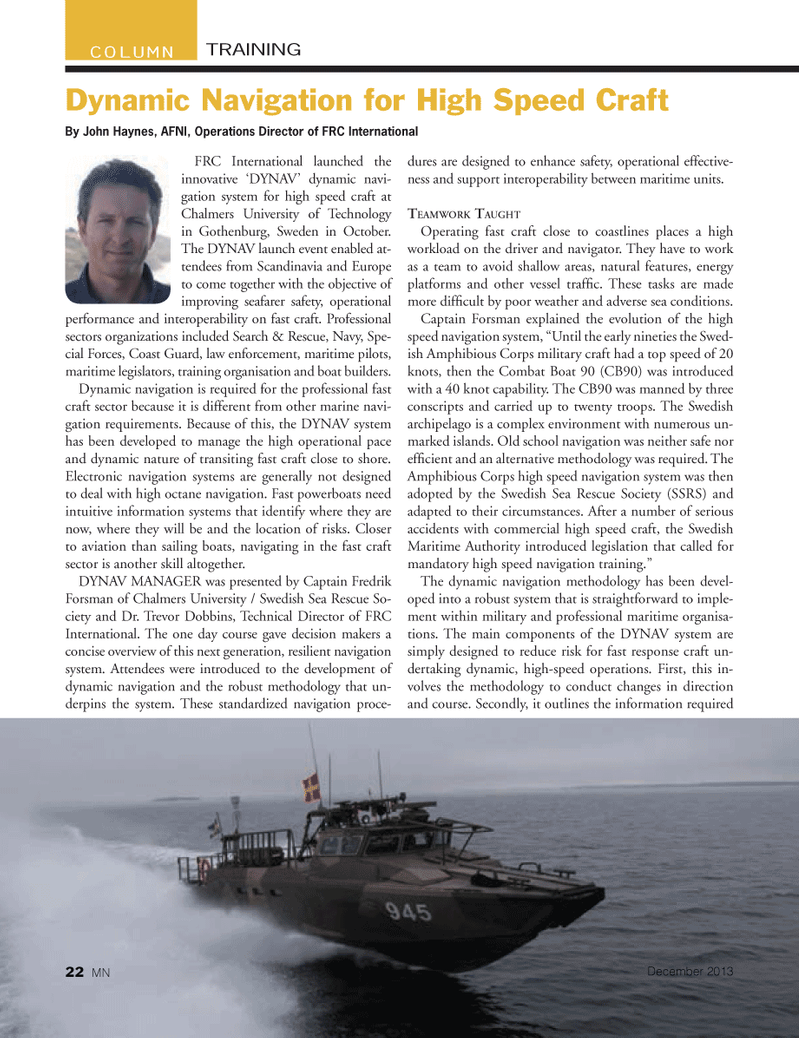
Page 22: of Marine News Magazine (December 2013)
Innovative Products & Boats of 2012
Read this page in Pdf, Flash or Html5 edition of December 2013 Marine News Magazine
FRC International launched the innovative ?DYNAV? dynamic navi- gation system for high speed craft at Chalmers University of Technology in Gothenburg, Sweden in October. The DYNAV launch event enabled at- tendees from Scandinavia and Europe to come together with the objective of improving seafarer safety, operational performance and interoperability on fast craft. Professional sectors organizations included Search & Rescue, Navy, Spe- cial Forces, Coast Guard, law enforcement, maritime pilots, maritime legislators, training organisation and boat builders.Dynamic navigation is required for the professional fast craft sector because it is different from other marine navi- gation requirements. Because of this, the DYNAV system has been developed to manage the high operational pace and dynamic nature of transiting fast craft close to shore. Electronic navigation systems are generally not designed to deal with high octane navigation. Fast powerboats need intuitive information systems that identify where they are now, where they will be and the location of risks. Closer to aviation than sailing boats, navigating in the fast craft sector is another skill altogether. DYNAV MANAGER was presented by Captain Fredrik Forsman of Chalmers University / Swedish Sea Rescue So- ciety and Dr. Trevor Dobbins, Technical Director of FRC International. The one day course gave decision makers a concise overview of this next generation, resilient navigation system. Attendees were introduced to the development of dynamic navigation and the robust methodology that un- derpins the system. These standardized navigation proce- dures are designed to enhance safety, operational effective- ness and support interoperability between maritime units. TEAMWORK TAUGHT Operating fast craft close to coastlines places a high workload on the driver and navigator. They have to work as a team to avoid shallow areas, natural features, energy platforms and other vessel traf c. These tasks are made more dif cult by poor weather and adverse sea conditions. Captain Forsman explained the evolution of the high speed navigation system, ?Until the early nineties the Swed- ish Amphibious Corps military craft had a top speed of 20 knots, then the Combat Boat 90 (CB90) was introduced with a 40 knot capability. The CB90 was manned by three conscripts and carried up to twenty troops. The Swedish archipelago is a complex environment with numerous un- marked islands. Old school navigation was neither safe nor ef cient and an alternative methodology was required. The Amphibious Corps high speed navigation system was then adopted by the Swedish Sea Rescue Society (SSRS) and adapted to their circumstances. After a number of serious accidents with commercial high speed craft, the Swedish Maritime Authority introduced legislation that called for mandatory high speed navigation training.? The dynamic navigation methodology has been devel- oped into a robust system that is straightforward to imple- ment within military and professional maritime organisa- tions. The main components of the DYNAV system are simply designed to reduce risk for fast response craft un- dertaking dynamic, high-speed operations. First, this in- volves the methodology to conduct changes in direction and course. Secondly, it outlines the information required Dynamic Navigation for High Speed Craft By John Haynes, AFNI, Operations Director of FRC International TRAININGCOLUMN22 MNDecember 2013MN Dec2013 Layout 18-31.indd 22MN Dec2013 Layout 18-31.indd 2211/25/2013 12:44:47 PM11/25/2013 12:44:47 PM

 21
21

 23
23
